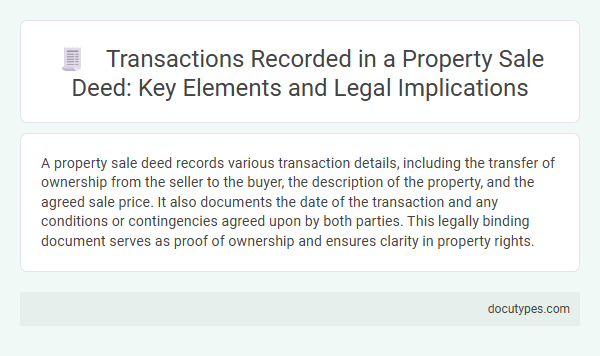A property sale deed records various transaction details, including the transfer of ownership from the seller to the buyer, the description of the property, and the agreed sale price. It also documents the date of the transaction and any conditions or contingencies agreed upon by both parties. This legally binding document serves as proof of ownership and ensures clarity in property rights.
Overview of Property Sale Deeds
| Transaction Type | Description |
|---|---|
| Property Transfer | Official transfer of ownership from the seller to the buyer, establishing legal rights. |
| Sale Price Details | Market value or agreed sale price of the property, ensuring clarity on the transaction amount. |
| Identification of Parties | Names and details of the buyer and seller, including legal identities and contact information. |
| Property Description | Comprehensive details about the property, including address, boundaries, and land or building specifics. |
| Legal Declarations | Statements regarding the property's legal status, encumbrances, and warranties against disputes. |
| Payment Terms | Specification of payment mode, schedule, and any conditions or deposits involved in the transaction. |
| Signatures and Witnesses | Authorization by the involved parties and witnesses, validating the authenticity and consent. |
| Registration Details | Entry of the deed in government property records, ensuring legal recognition and future reference. |
Essential Parties Involved in a Sale Deed
A property sale deed records the transfer of ownership from the seller to the buyer. It serves as a legally binding document that outlines the terms and conditions of the property transaction.
The essential parties involved in a sale deed include the seller, who transfers the property rights, and the buyer, who receives ownership. Other key participants may include witnesses and the registrar who oversees the deed's execution and registration.
Important Dates and Transaction Timeline
A property sale deed records key transactions, including the agreement date, payment milestones, and ownership transfer date. Important dates such as the signing of the contract, deposit payments, and final deed registration are documented to establish the transaction timeline. Your property sale deed ensures clear evidence of all significant events involved in the transfer of ownership.
Detailed Description of the Property
A property sale deed records crucial details about the transaction and the property itself to ensure legal clarity. Understanding the detailed description of the property helps protect your ownership rights and validates the sale.
- Legal Description - Specifies the official boundaries and dimensions of the property using survey data or metes and bounds.
- Property Address - Identifies the exact location by street address, city, and postal code for precise identification.
- Parcel Number - Includes a unique identification number assigned by local government or land registry for clear tracking.
Sale Consideration and Payment Terms
What types of transactions are recorded in a property sale deed regarding sale consideration and payment terms? The sale deed specifies the exact amount agreed upon as the sale consideration, ensuring clarity on the property's price. It also details the payment terms, including the mode, timeline, and conditions under which you will complete the payment.
Encumbrances and Title Verification
A property sale deed records various transactions, including the transfer of ownership rights from the seller to the buyer. It details any encumbrances such as mortgages, liens, or easements that may affect the property's title. Title verification ensures that the seller holds a clear and marketable title, free from disputes or legal claims.
Execution, Witnesses, and Registration Process
The property sale deed records the execution of the agreement, detailing the transfer of ownership from the seller to the buyer. This section includes the date, signatures of both parties, and the agreed terms of sale.
The deed also contains information about witnesses who attest to the authenticity of the transaction. Typically, two or more witnesses sign the document to validate the execution process.
Registration of the sale deed is a critical legal step, ensuring the transaction is officially recorded with the local property registrar. This process protects the buyer's ownership rights and helps prevent future disputes.
The registration requires submitting the original sale deed, identity proofs, and payment of stamp duty and registration fees. Upon completion, the registrar updates the government records, confirming the new ownership.
Legal Implications of Misrepresentation
A property sale deed records key transactions such as the transfer of ownership, sale price, and description of the property. It includes parties involved, payment terms, and any encumbrances or liens on the property.
Misrepresentation in a property sale deed carries significant legal implications including contract nullification and claims for damages. Buyers misled by false information may seek rescission of the sale or compensation for incurred losses. Courts closely scrutinize the accuracy of statements made during the transaction to protect parties from fraud and ensure fair dealings.
Stamp Duty and Registration Fees
A property sale deed records various transactions essential to legal ownership transfer. Stamp duty and registration fees are critical financial components documented in the deed.
- Stamp Duty - This is a government-imposed tax calculated based on the property's sale value and is mandatory for validating the sale deed.
- Registration Fees - These fees are paid to the local registrar's office to officially record the property transaction and update ownership records.
- Transaction Details - The deed also captures the sale amount, buyer and seller information, and agreed terms, ensuring legal clarity and enforceability.
What Types of Transactions Are Recorded in a Property Sale Deed? Infographic

